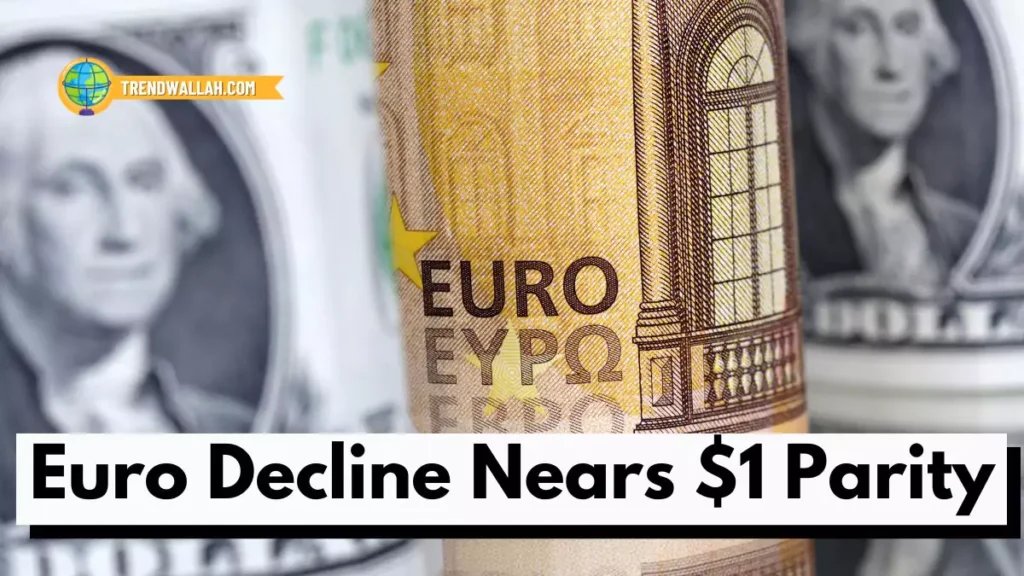
The euro has dropped to its lowest level in a year, trading around $1.05, and is now just 5% away from parity with the U.S. dollar. This decline has reignited discussions about the euro potentially hitting the $1 mark, a level it last neared in early 2022. Market concerns are fueled by Donald Trump’s recent election win, which could lead to higher tariffs, adding pressure on the eurozone economy.
Current Status of the Euro
The euro currently sits near $1.05, reflecting a 6% decline from September’s high. Analysts attribute this drop to a bleak economic outlook within the eurozone. The euro-dollar pair remains the world’s most heavily traded currency pair, keeping global eyes on its performance.
Could the Euro Reach Parity with the Dollar?
The $1 mark is a crucial psychological barrier, and if breached, it could result in further weakening of the euro. While the euro briefly traded below parity in 2022 due to rapidly rising U.S. interest rates and Europe’s energy crisis, a similar fall could occur if tariff increases become a reality. Deutsche Bank and JPMorgan have projected parity is possible, contingent on economic conditions and inflation controls.
Economic Implications: How a Weak Euro Affects Imports and Exports
A weak euro raises the cost of imports, potentially driving up prices of food, energy, and raw materials. However, inflation in the eurozone has been easing recently, which reduces immediate concerns. On the positive side, a lower euro benefits exporters as European goods become cheaper abroad, particularly aiding sectors like automobiles, industrial goods, and luxury items. This boost is especially beneficial for Germany, the eurozone’s largest economy and a major exporter.
Comparison with Other Currencies Facing Tariff Concerns
The euro isn’t the only currency feeling the strain. Other currencies, including the Mexican peso and Korean won, have also suffered losses recently, affected by fears of rising tariffs. For example, the peso and won have each fallen around 5-6%. The Japanese yen has also seen notable losses, down nearly 10% against the dollar this year.
What’s Next for the Euro? Potential ECB Actions
Some analysts remain cautiously optimistic, predicting that parity isn’t inevitable. The European Central Bank (ECB) may take measures to support the euro if necessary, such as potential interest rate cuts. The ECB is watching the euro’s performance relative to a basket of global currencies, with the aim of ensuring stability. Recent growth in the eurozone’s economy also provides hope for a stabilizing effect.
Euro’s Current Economic Impact
| Factor | Implication |
| Euro Near Parity | Possible 5% drop could see euro hit $1 |
| Import Costs | Increased costs for food, energy, and raw materials |
| Export Benefits | Eurozone exports become cheaper, boosting sectors like automotive |
| Comparison with Other Currencies | Euro’s 4.5% decline mirrors drops in peso and won |
| Potential ECB Actions | Possible interest rate cuts to support euro stability |
Euro Decline News Summary:
- Euro nears $1 parity, trading at $1.05 after a 6% drop since September.
- Higher tariffs due to U.S. policy could worsen the euro’s decline.
- A weaker euro raises import costs but makes exports cheaper, benefiting German exports.
- Other currencies, such as the Mexican peso and Korean won, also fell.
- ECB may consider interest rate adjustments if needed to stabilize the euro.
Also Read Latest Current Affairs 2024
FAQs (People Also Ask Section)
The euro is nearing parity with the dollar due to a weaker eurozone economy, increased tariff concerns, and global inflation trends.
A weaker euro can increase import prices, potentially causing higher costs for goods. However, it also benefits exporters by making their products cheaper overseas.
Yes, the euro fell below $1 briefly in 2022 and in the early 2000s, influenced by factors such as higher U.S. interest rates.
If the euro drops below $1, it could lead to more selling and further depreciation, potentially impacting inflation and imports.
A lower euro makes German goods cheaper abroad, supporting the country’s export-driven economy, especially in the automotive and manufacturing sectors.
The ECB monitors currency trends and could introduce rate cuts if needed to stabilize the euro and support the eurozone economy.
The Mexican peso, Korean won, and Japanese yen have all recently dropped due to similar concerns, mirroring the euro’s decline.
